Abstract
Augmentation of lung antiprotease levels may be an important therapeutic intervention in the prevention of pulmonary emphysema. We have administered aerosols of plasma-derived human alpha 1 proteinase inhibitor (A1PI) to the lungs of dogs and sheep to investigate (a) delivery of the protein to the distal air spaces of the lung; (b) maintenance of functional activity of the protein; and (c) flux of the protein across the components of the alveolar-capillary membrane. A1PI (26.4 mg/kg body weight) was administered as an aerosol to anesthetized animals; sheep were prepared for the chronic collection of lung lymph. Immunoperoxidase staining of lung tissue obtained 2 h after administration of A1PI demonstrated the presence of human A1PI on the surface of alveoli and distal bronchioles. Bronchoalveolar lavage fluid recovered at intervals after A1PI administration demonstrated time-dependent elevations of human A1PI levels with augmentation of lavage fluid antielastase activity in proportion to the content of human A1PI. Using radiolabeled A1PI as a tracer, we found that 32% of the aerosol was retained in the animals' lungs. Measurements of the rate of loss of A1PI from the lung and of the rate of appearance of human A1PI in plasma resulted in a calculated permeability of the alveolar-capillary membrane to A1PI of 3.49-6.39 X 10(-10) cm/s. Experiments using instrumented sheep allowed independent calculation of endothelial permeability to A1PI of 122-236 X 10(-10) cm/s and calculation of epithelial permeability of 4.70-4.81 X 10(-10) cm/s. Modeling of aerosol delivery of A1PI to humans using the results of these studies predicts that the ratio of plasma/alveolar levels of delivered A1PI will be 0.024, and that aerosolization of 175 mg A1PI/d will result in an A1PI alveolar fluid level of 1.0 mg/ml. Aerosol administration of A1PI may provide an efficient method of augmenting alveolar antiprotease levels.
Full text
PDF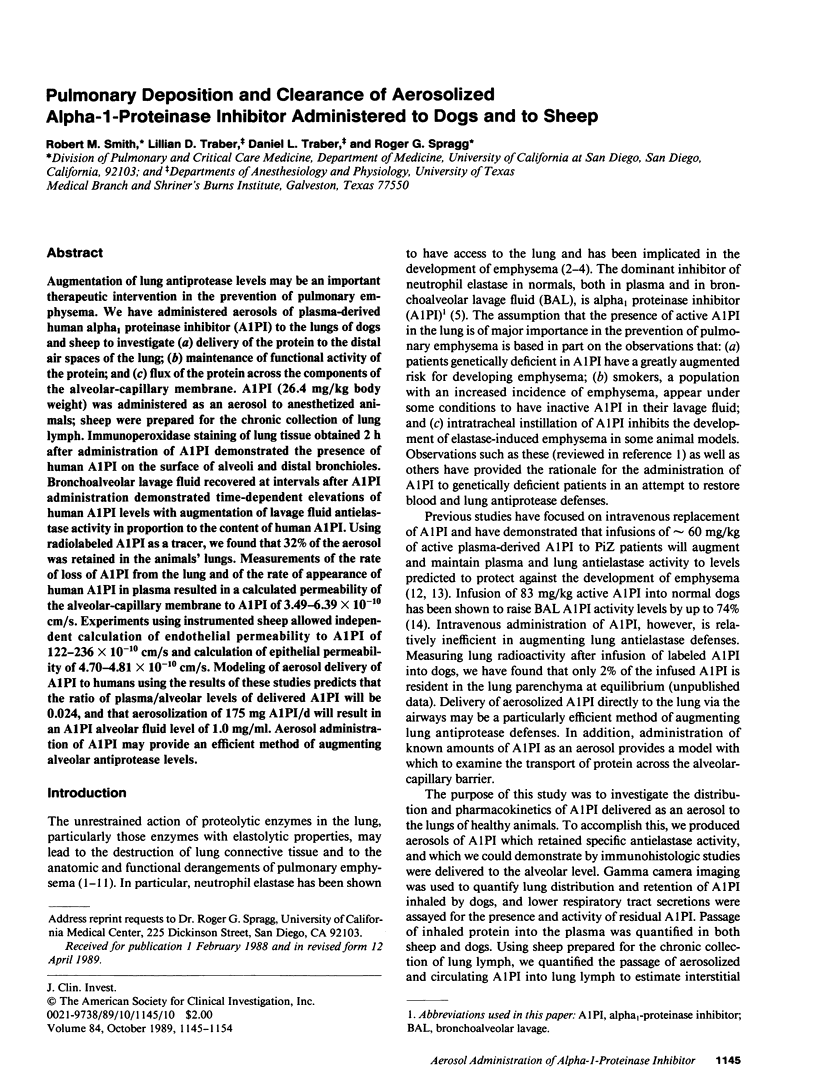
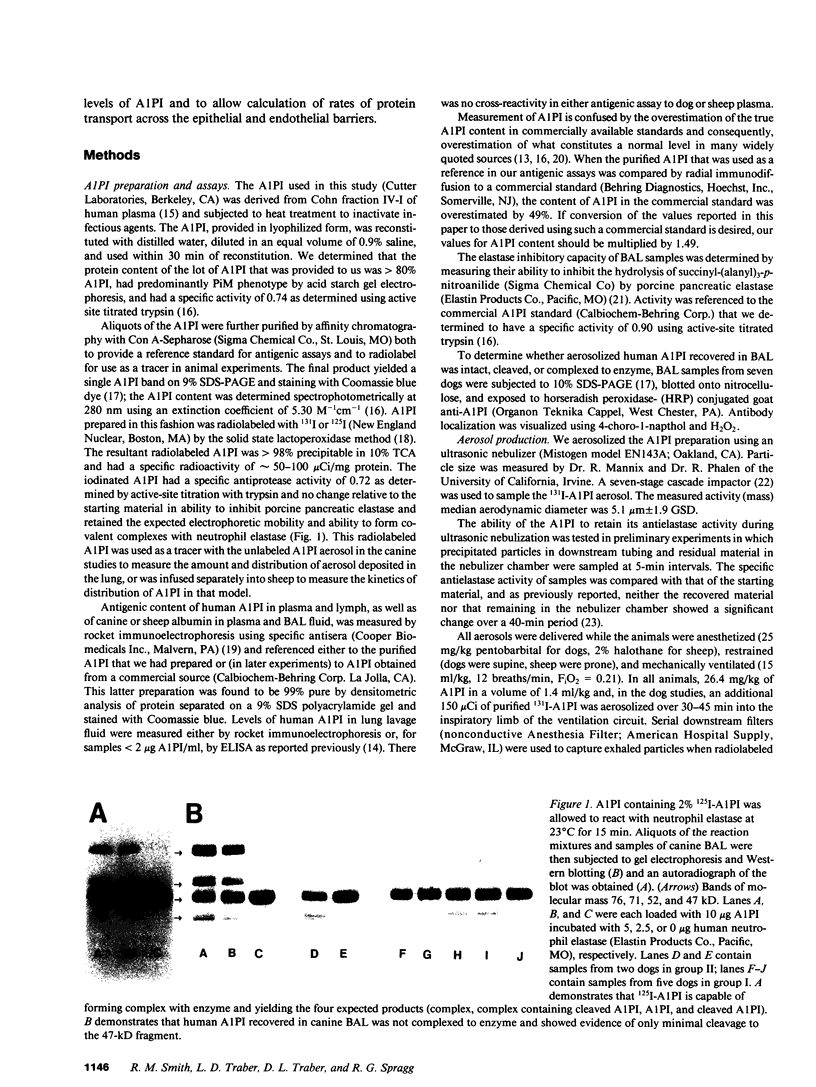
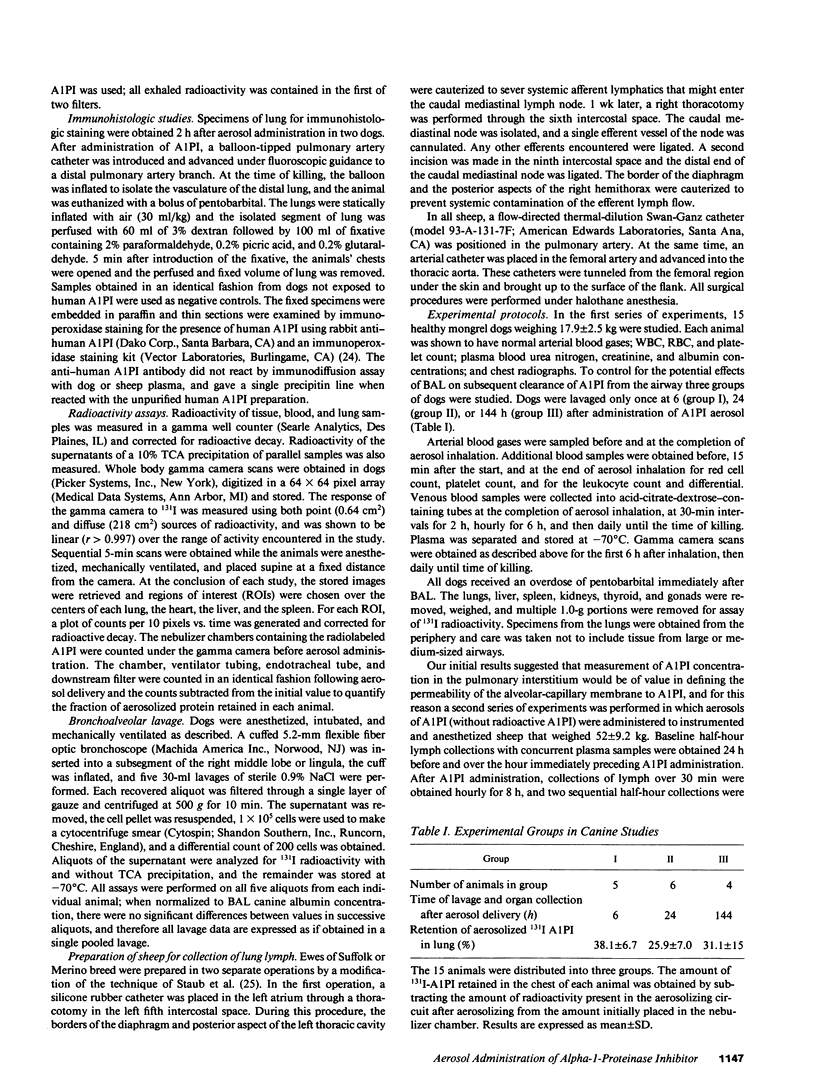
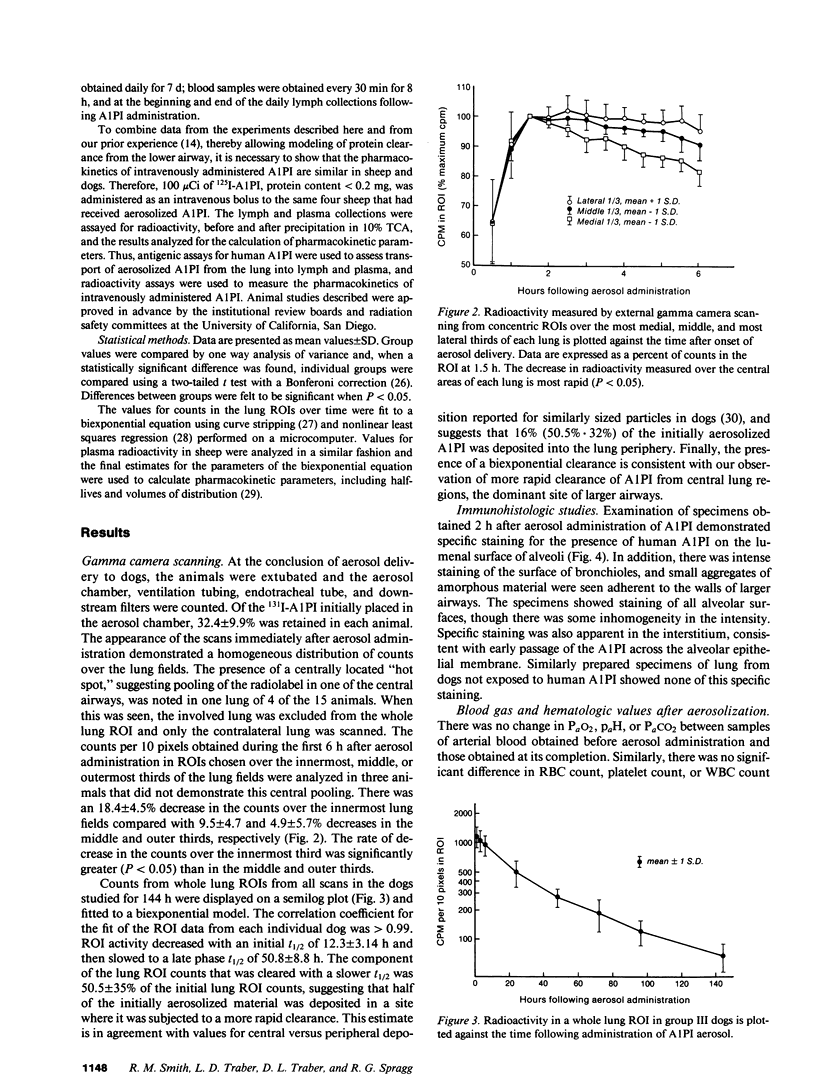
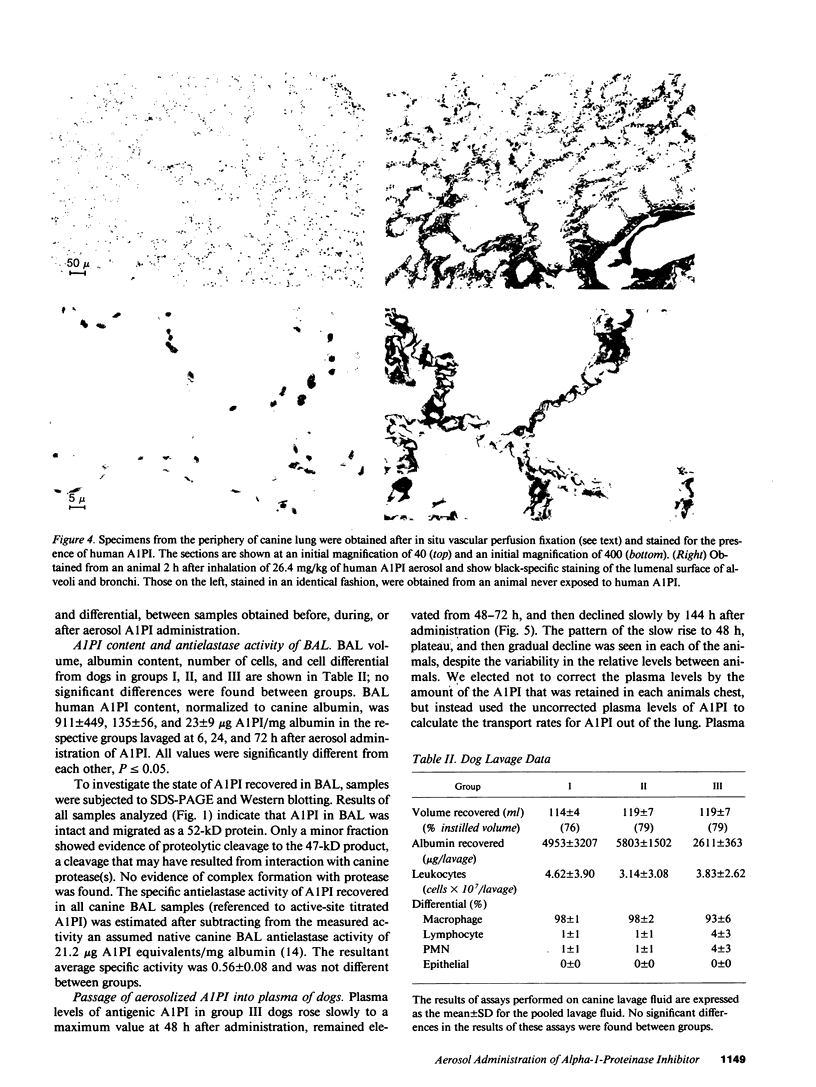
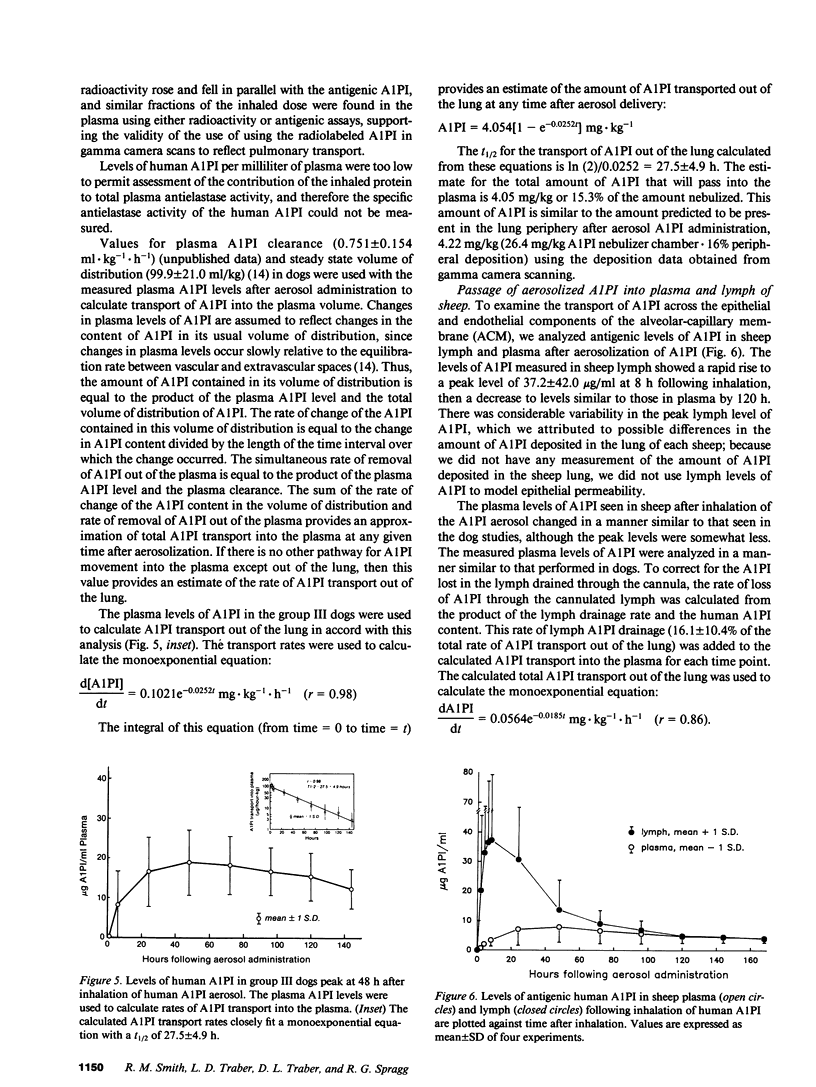
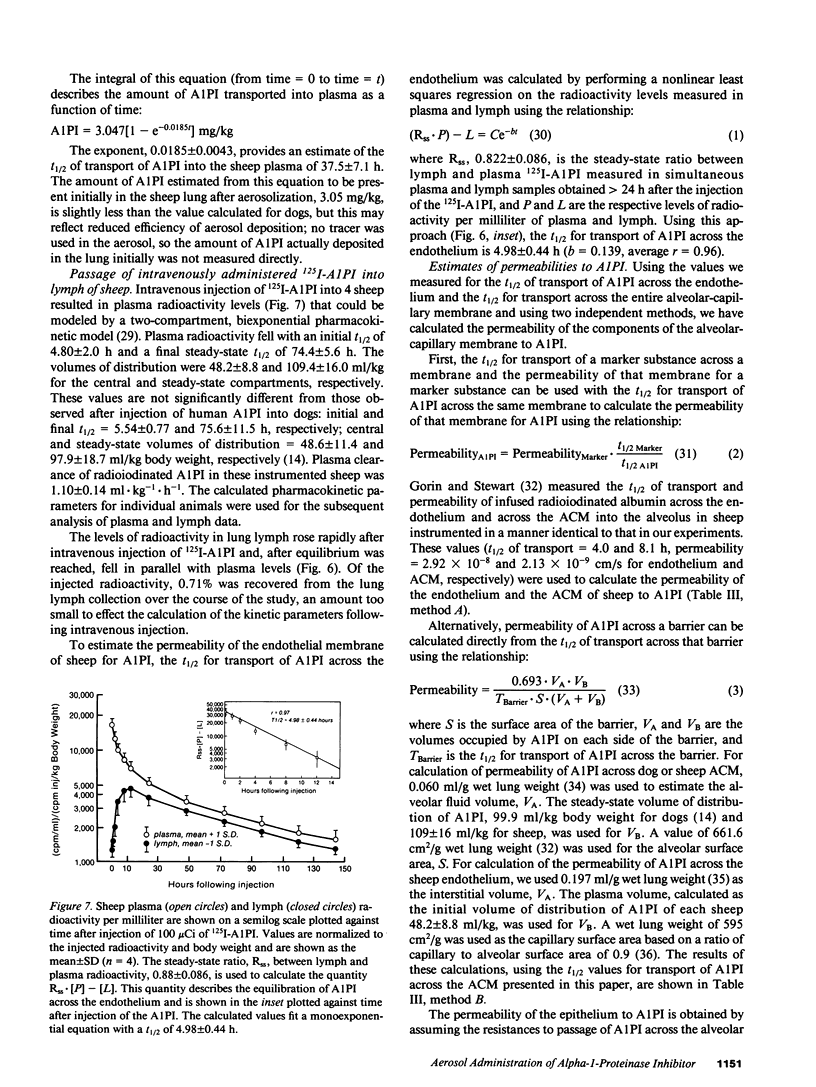
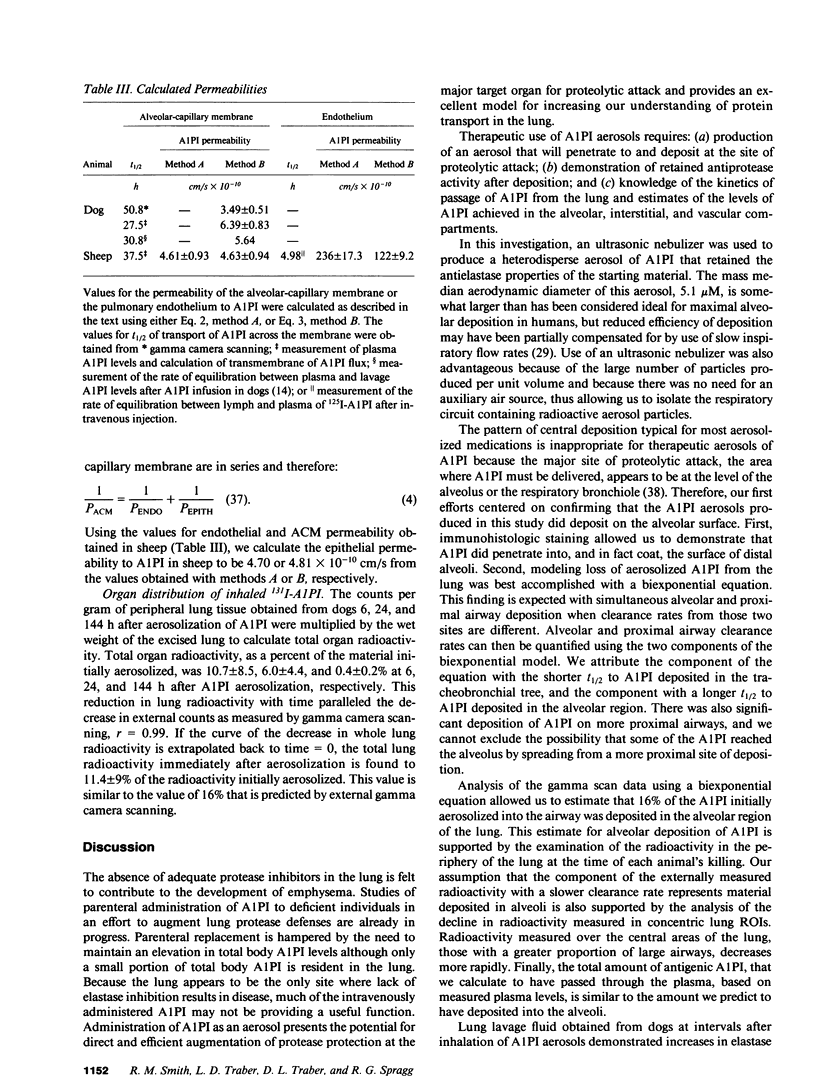
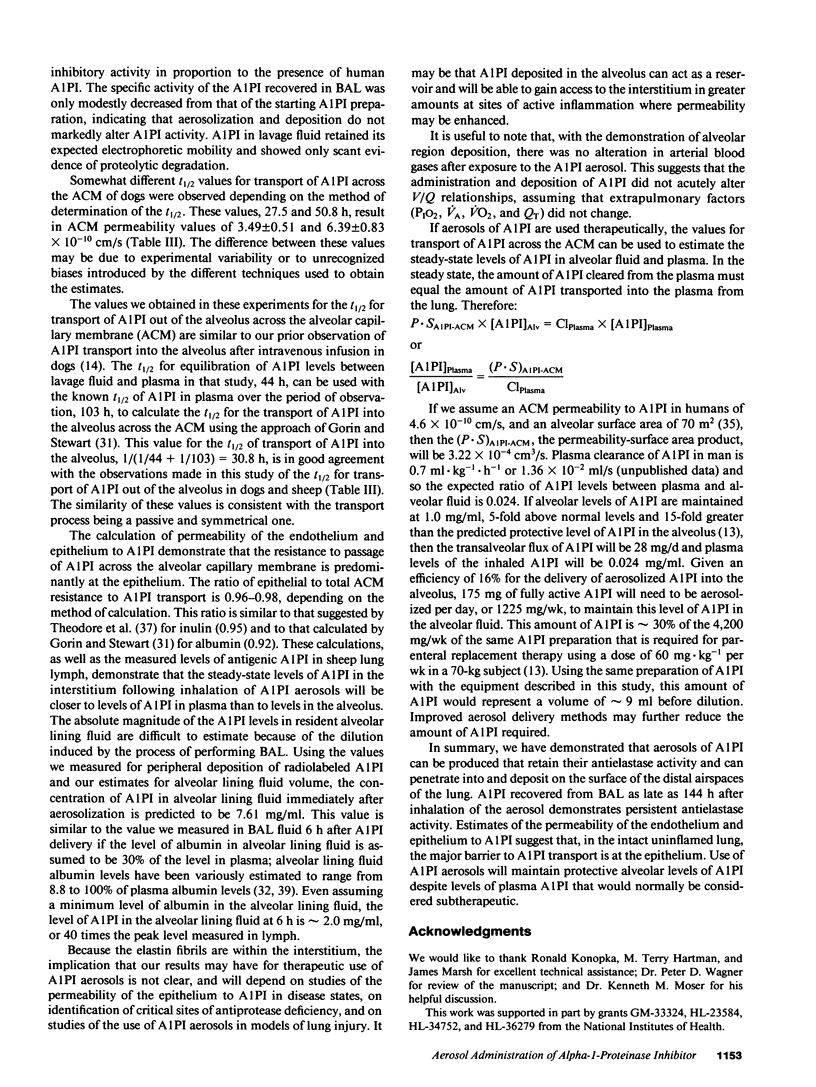
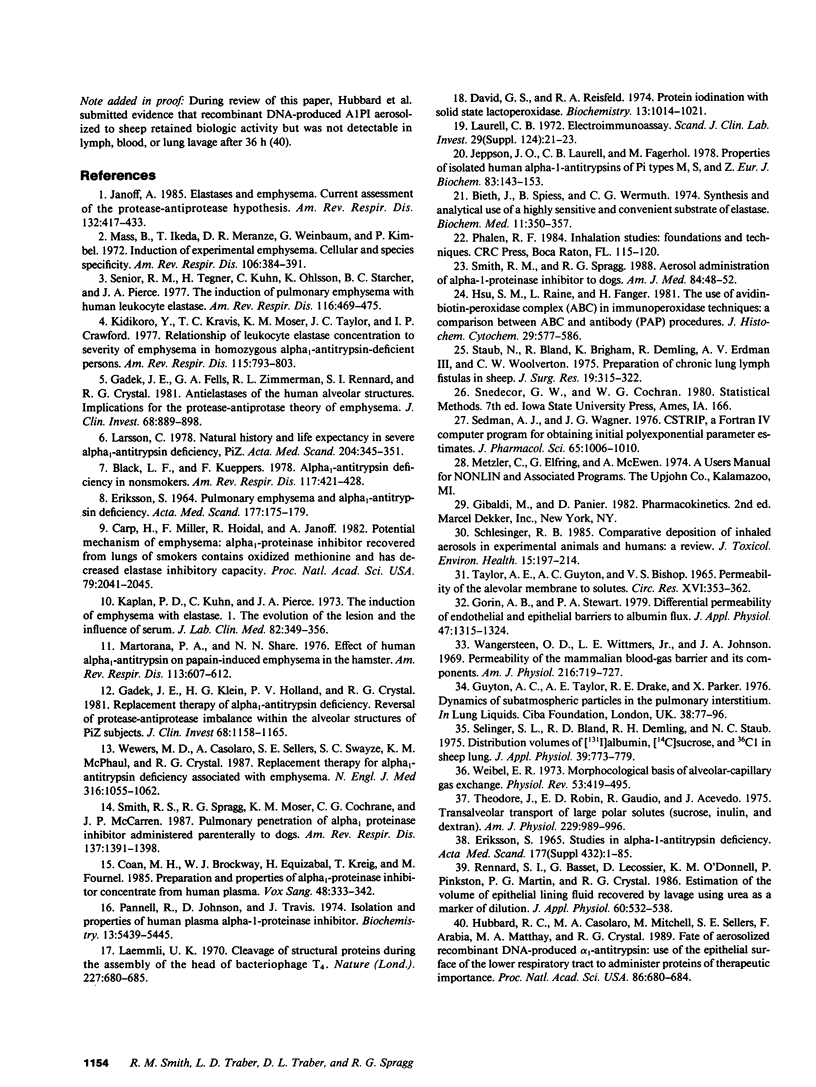
Images in this article
Selected References
These references are in PubMed. This may not be the complete list of references from this article.
- Bieth J., Spiess B., Wermuth C. G. The synthesis and analytical use of a highly sensitive and convenient substrate of elastase. Biochem Med. 1974 Dec;11(4):350–357. doi: 10.1016/0006-2944(74)90134-3. [DOI] [PubMed] [Google Scholar]
- Black L. F., Kueppers F. alpha1-Antitrypsin deficiency in nonsmokers. Am Rev Respir Dis. 1978 Mar;117(3):421–428. doi: 10.1164/arrd.1978.117.3.421. [DOI] [PubMed] [Google Scholar]
- Carp H., Miller F., Hoidal J. R., Janoff A. Potential mechanism of emphysema: alpha 1-proteinase inhibitor recovered from lungs of cigarette smokers contains oxidized methionine and has decreased elastase inhibitory capacity. Proc Natl Acad Sci U S A. 1982 Mar;79(6):2041–2045. doi: 10.1073/pnas.79.6.2041. [DOI] [PMC free article] [PubMed] [Google Scholar]
- Coan M. H., Brockway W. J., Eguizabal H., Krieg T., Fournel M. Preparation and properties of alpha 1-proteinase inhibitor concentrate from human plasma. Vox Sang. 1985;48(6):333–342. doi: 10.1111/j.1423-0410.1985.tb00193.x. [DOI] [PubMed] [Google Scholar]
- David G. S., Reisfeld R. A. Protein iodination with solid state lactoperoxidase. Biochemistry. 1974 Feb 26;13(5):1014–1021. doi: 10.1021/bi00702a028. [DOI] [PubMed] [Google Scholar]
- Eriksson S. Studies in alpha 1-antitrypsin deficiency. Acta Med Scand Suppl. 1965;432:1–85. [PubMed] [Google Scholar]
- Gadek J. E., Fells G. A., Zimmerman R. L., Rennard S. I., Crystal R. G. Antielastases of the human alveolar structures. Implications for the protease-antiprotease theory of emphysema. J Clin Invest. 1981 Oct;68(4):889–898. doi: 10.1172/JCI110344. [DOI] [PMC free article] [PubMed] [Google Scholar]
- Gadek J. E., Klein H. G., Holland P. V., Crystal R. G. Replacement therapy of alpha 1-antitrypsin deficiency. Reversal of protease-antiprotease imbalance within the alveolar structures of PiZ subjects. J Clin Invest. 1981 Nov;68(5):1158–1165. doi: 10.1172/JCI110360. [DOI] [PMC free article] [PubMed] [Google Scholar]
- Gorin A. B., Stewart P. A. Differential permeability of endothelial and epithelial barriers to albumin flux. J Appl Physiol Respir Environ Exerc Physiol. 1979 Dec;47(6):1315–1324. doi: 10.1152/jappl.1979.47.6.1315. [DOI] [PubMed] [Google Scholar]
- Hsu S. M., Raine L., Fanger H. Use of avidin-biotin-peroxidase complex (ABC) in immunoperoxidase techniques: a comparison between ABC and unlabeled antibody (PAP) procedures. J Histochem Cytochem. 1981 Apr;29(4):577–580. doi: 10.1177/29.4.6166661. [DOI] [PubMed] [Google Scholar]
- Hubbard R. C., Casolaro M. A., Mitchell M., Sellers S. E., Arabia F., Matthay M. A., Crystal R. G. Fate of aerosolized recombinant DNA-produced alpha 1-antitrypsin: use of the epithelial surface of the lower respiratory tract to administer proteins of therapeutic importance. Proc Natl Acad Sci U S A. 1989 Jan;86(2):680–684. doi: 10.1073/pnas.86.2.680. [DOI] [PMC free article] [PubMed] [Google Scholar]
- Janoff A. Elastases and emphysema. Current assessment of the protease-antiprotease hypothesis. Am Rev Respir Dis. 1985 Aug;132(2):417–433. doi: 10.1164/arrd.1985.132.2.417. [DOI] [PubMed] [Google Scholar]
- Jeppsson J. O., Laurell C. B., Fagerhol M. Properties of isolated human alpha1-antitrypsins of Pi types M, S and Z. Eur J Biochem. 1978 Feb 1;83(1):143–153. doi: 10.1111/j.1432-1033.1978.tb12078.x. [DOI] [PubMed] [Google Scholar]
- Kaplan P. D., Kuhn C., Pierce J. A. The induction of emphysema with elastase. I. The evolution of the lesion and the influence of serum. J Lab Clin Med. 1973 Sep;82(3):349–356. [PubMed] [Google Scholar]
- Kidokoro Y., Kravis T. C., Moser K. M., Taylor J. C., Crawford I. P. Relationship of leukocyte elastase concentration to severity of emphysema in homozygous alpha1-antitrypsin-deficient persons. Am Rev Respir Dis. 1977 May;115(5):793–803. doi: 10.1164/arrd.1977.115.5.793. [DOI] [PubMed] [Google Scholar]
- Laemmli U. K. Cleavage of structural proteins during the assembly of the head of bacteriophage T4. Nature. 1970 Aug 15;227(5259):680–685. doi: 10.1038/227680a0. [DOI] [PubMed] [Google Scholar]
- Larsson C. Natural history and life expectancy in severe alpha1-antitrypsin deficiency, Pi Z. Acta Med Scand. 1978;204(5):345–351. doi: 10.1111/j.0954-6820.1978.tb08452.x. [DOI] [PubMed] [Google Scholar]
- Laurell C. B. Electroimmuno assay. Scand J Clin Lab Invest Suppl. 1972;124:21–37. doi: 10.3109/00365517209102748. [DOI] [PubMed] [Google Scholar]
- Martorana P. A., Share N. N. Effect of human alpha-antitrypsin in papain-induced emphysema in the hamster. Am Rev Respir Dis. 1976 May;113(5):607–612. doi: 10.1164/arrd.1976.113.5.607. [DOI] [PubMed] [Google Scholar]
- Mass B., Ikeda T., Meranze D. R., Weinbaum G., Kimbel P. Induction of experimental emphysema. Cellular and species specificity. Am Rev Respir Dis. 1972 Sep;106(3):384–391. doi: 10.1164/arrd.1972.106.3.384. [DOI] [PubMed] [Google Scholar]
- Pannell R., Johnson D., Travis J. Isolation and properties of human plasma alpha-1-proteinase inhibitor. Biochemistry. 1974 Dec 17;13(26):5439–5445. doi: 10.1021/bi00723a031. [DOI] [PubMed] [Google Scholar]
- Rennard S. I., Basset G., Lecossier D., O'Donnell K. M., Pinkston P., Martin P. G., Crystal R. G. Estimation of volume of epithelial lining fluid recovered by lavage using urea as marker of dilution. J Appl Physiol (1985) 1986 Feb;60(2):532–538. doi: 10.1152/jappl.1986.60.2.532. [DOI] [PubMed] [Google Scholar]
- Schlesinger R. B. Comparative deposition of inhaled aerosols in experimental animals and humans: a review. J Toxicol Environ Health. 1985;15(2):197–214. doi: 10.1080/15287398509530647. [DOI] [PubMed] [Google Scholar]
- Sedman A. J., Wagner J. G. CSTRIP, a fortran IV computer program for obtaining initial polyexponential parameter estimates. J Pharm Sci. 1976 Jul;65(7):1006–1010. doi: 10.1002/jps.2600650713. [DOI] [PubMed] [Google Scholar]
- Selinger S. L., Bland R. D., Demling R. H., Staub N. C. Distribution volumes of [131I]albumin, [14C]sucrose, and 36Cl in sheep lung. J Appl Physiol. 1975 Nov;39(5):773–779. doi: 10.1152/jappl.1975.39.5.773. [DOI] [PubMed] [Google Scholar]
- Senior R. M., Tegner H., Kuhn C., Ohlsson K., Starcher B. C., Pierce J. A. The induction of pulmonary emphysema with human leukocyte elastase. Am Rev Respir Dis. 1977 Sep;116(3):469–475. doi: 10.1164/arrd.1977.116.3.469. [DOI] [PubMed] [Google Scholar]
- Smith R. M., Spragg R. G., Moser K. M., Cochrane C. G., McCarren J. P. Pulmonary penetration of alpha 1-proteinase inhibitor administered parenterally to dogs. Am Rev Respir Dis. 1987 Dec;136(6):1391–1396. doi: 10.1164/ajrccm/136.6.1391. [DOI] [PubMed] [Google Scholar]
- Smith R. M., Spragg R. G. Production and administration to dogs of aerosols of alpha-1-proteinase inhibitor. Am J Med. 1988 Jun 24;84(6A):48–51. doi: 10.1016/0002-9343(88)90158-1. [DOI] [PubMed] [Google Scholar]
- Staub N. C., Bland R. D., Brigham K. L., Demling R., Erdmann A. J., 3rd, Woolverton W. C. Preparation of chronic lung lymph fistulas in sheep. J Surg Res. 1975 Nov;19(5):315–320. doi: 10.1016/0022-4804(75)90056-6. [DOI] [PubMed] [Google Scholar]
- TAYLOR A. E., GUYTON A. C., BISHOP V. S. PERMEABILITY OF THE ALVEOLAR MEMBRANE TO SOLUTES. Circ Res. 1965 Apr;16:353–362. doi: 10.1161/01.res.16.4.353. [DOI] [PubMed] [Google Scholar]
- Theodore J., Robin E. D., Gaudio R., Acevedo J. Transalveolar transport of large polar solutes (sucrose, inulin, and dextran). Am J Physiol. 1975 Oct;229(4):989–996. doi: 10.1152/ajplegacy.1975.229.4.989. [DOI] [PubMed] [Google Scholar]
- Wangensteen O. D., Wittmers L. E., Jr, Johnson J. A. Permeability of the mammalian blood-gas barrier and its components. Am J Physiol. 1969 Apr;216(4):719–727. doi: 10.1152/ajplegacy.1969.216.4.719. [DOI] [PubMed] [Google Scholar]
- Weibel E. R. Morphological basis of alveolar-capillary gas exchange. Physiol Rev. 1973 Apr;53(2):419–495. doi: 10.1152/physrev.1973.53.2.419. [DOI] [PubMed] [Google Scholar]
- Wewers M. D., Casolaro M. A., Sellers S. E., Swayze S. C., McPhaul K. M., Wittes J. T., Crystal R. G. Replacement therapy for alpha 1-antitrypsin deficiency associated with emphysema. N Engl J Med. 1987 Apr 23;316(17):1055–1062. doi: 10.1056/NEJM198704233161704. [DOI] [PubMed] [Google Scholar]




